Dumbbell lat exercises are an excellent approach to build total upper body strength and to strengthen and tone your back muscles. Adding lat exercises to your regimen can have a big impact, regardless of how experienced you are at the gym or how new you are to fitness. This post will cover what you need to know to conduct efficient lat workouts with dumbbells, from setting up a detailed training plan to using the right form and technique.
What Are Dumbbell Lat Exercises?
Dumbbell lat exercises are designed to target the latissimus dorsi muscles, which are the large muscles of the back that give the back its width and contribute significantly to movements involving pulling and lifting. Some dumbbell exercises that target the lats include dumbbell rows, dumbbell pullovers, dumbbell pull-overs on a stability ball, dumbbell pulldowns, dumbbell lat raises, and single-arm dumbbell deadlifts.
When performing Lat Workouts with Dumbbells, you should slightly lean forward, hold a dumbbell in each hand, and then draw the weights up towards your sides while maintaining a close elbow stance. Your lats, or the muscles on either side of your back, and your upper back muscles are worked out during this exercise.
Dumbbell pullovers involve lying down on a bench with your upper back and shoulders supported, holding a dumbbell above your chest with your arms slightly bent. This exercise targets the lats and also engages the chest and triceps.
How To Target Lat Muscles With Dumbbells
To target lat muscles using dumbbells, perform various exercises that focus on pulling movements. These include dumbbell rows, pullovers, pulldowns, and single-arm deadlifts. Stand with feet shoulder-width apart, holding a dumbbell with palms facing your body. Bend your knees slightly and hinge forward at your hips, keeping your back straight and core engaged. Pull the dumbbells up towards your sides, keeping your elbows close to your body and squeezing your shoulder blades together. Lower the dumbbells back down with control and repeat for the desired number of repetitions.
To do lat workouts with dumbbells, you’ll need a special handle attached to a high machine or a strong band tied up high. Grab the handle and pull it down towards your side while keeping your elbow close to your body. This helps work your back muscles called ‘lats’. Then, slowly let go of the handle and let it go back up. Do this a few times.”
Benefits of Lat Workouts
There are several practical and aesthetic advantages to lat exercises. Here are a few of the main advantages:
- Increased Back Strength: Focuses on the latissimus dorsi, the largest muscles in the back, enhancing overall strength and reducing the risk of back pain or injury.
- Improved Muscle Bulk and Definition: Consistent lat exercises can enhance the back’s muscular bulk and definition, promoting a toned and sculpted body.
- Enhanced Upper Body Functionality: Strengthening lat muscles enhances performance in pull-ups, weightlifting, and daily chores.
- Enhanced Athletic Performance: Strong lats improve agility and movement efficiency in various sports and physical activities.
- Balanced Body: Lat workouts help create a well-rounded body by balancing out the back muscles.
- Enhanced Metabolism: Lat workouts can boost metabolism and aid in fat loss.
- Better Posture: Strengthening lats improves posture by drawing shoulders back and down, counteracting slouching or rounded shoulders, and promoting a more erect posture.
All things considered, adding lat exercises to your training regimen can be quite beneficial to your strength, body, and general health. Making lat exercises a priority will help you reach your fitness objectives, whether they want to gain muscle, increase performance, or improve posture.
Top 9 Lat Workouts with Dumbbells
Single Arm Dumbbell Row
A great exercise for working the latissimus dorsi, rhomboids, and trapezius muscles in the upper back is the single-arm dumbbell row. It also works the forearms and biceps, albeit not as much. This unilateral exercise strengthens the muscles on each side of the body separately and aids in the correction of muscle imbalances.
Step-by-Step Guide:
- Set up dumbbell on a level bench parallel to the ground.
- Take a split stance with one foot in front and the other behind.
- Position hand and knee under shoulder and knee under hip for support.
- Maintain a neutral spine and strong core for lower back support.
- Use a solid grip with the hand resting on the bench and opposite the knee.
- Maintain a regular breathing pattern throughout the exercise.
- Complete required repetitions on one side before moving to the other.
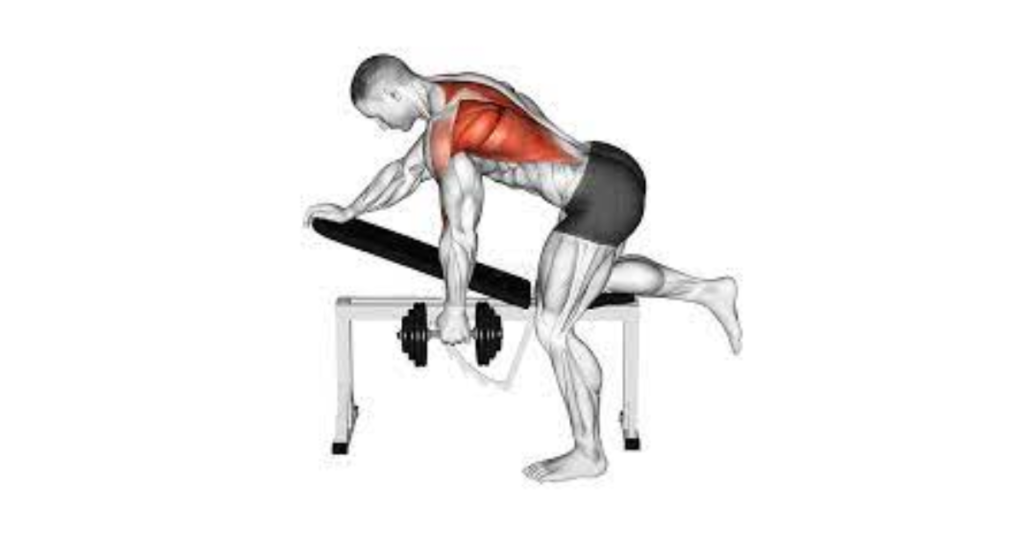
Dumbbell Bent-Over Row
The latissimus dorsi, rhomboids, and traps are among the upper back muscles that are principally worked during the dumbbell bent-over row, a complex exercise. As secondary muscles, it also works the forearms and biceps. This exercise is good for strengthening the upper body, correcting posture, and developing the back muscles more fully overall.
Step-by-Step Guide:
- Hold dumbbells with overhand grip, feet shoulder-width apart.
- Maintain straight arm position in front of you.
- Flex knees and turn hips forward.
- Maintain back flat using core muscles.
- Controllably raise weights towards ribs, keeping elbows tight to torso.
- Pull until upper arms are parallel to floor and dumbbells are below chest.
- Tighten back muscles towards peak.
- Lower dumbbells back to starting position, avoiding full arm extension.
- Continue until desired number of repetitions.
- Breathe steadily throughout the workout.
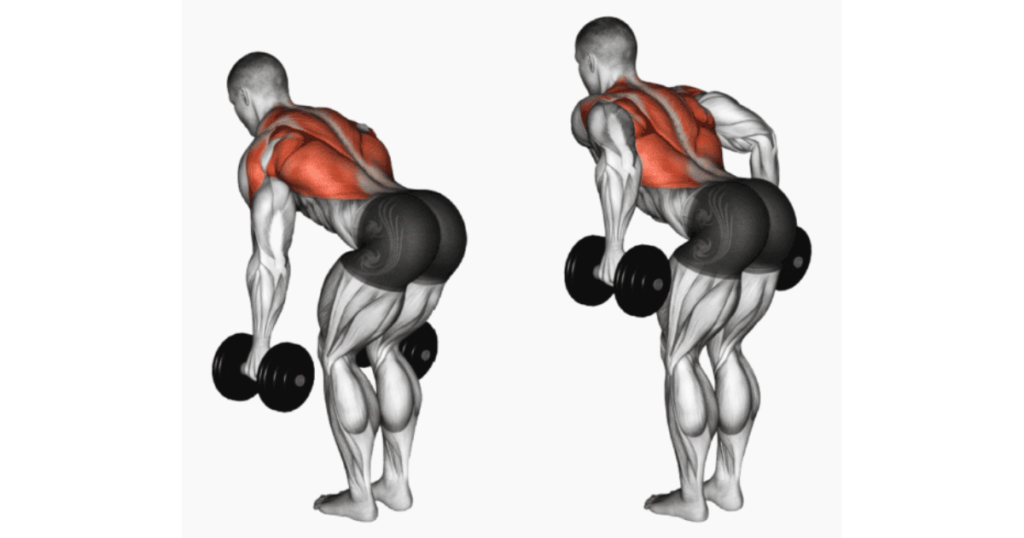
Dumbbell Lat Pullover
A traditional exercise that targets the latissimus dorsi muscles, which are found on the sides of your back, is the dumbbell lat pullover. It is a complex activity that can assist train many muscular groups at once because it also works the shoulders, triceps, and chest muscles. This workout is frequently used to strengthen the upper body and enhance the overall definition of the muscles.
Step-by-Step Guide:
- Setting up your equipment: To start, choose a dumbbell weight that is adequate for your degree of strength. Place your feet firmly on the floor and lie down on a level bench. Make sure the bench provides complete support for your head, shoulders, and upper back during the activity.
- Grip Placement: Using both hands, firmly grasp a single dumbbell by its end in an overhand grip. Press your palms firmly against the dumbbell plate’s underside.
- Beginning Position: Raise your arms straight over your chest, bending your elbows just a little bit. This is how the exercise should start.
- Lowering Phase: Breathe deeply, then slowly and deliberately lower the dumbbell behind your head, keeping your elbows slightly bent. To keep your body stable during the exercise, keep your core active. Lower the dumbbell until your upper arms are either slightly below or parallel to the floor.
- Stretch and Contraction: Take a moment to pause at the bottom of the movement so that your lats and chest muscles may experience a deep stretch. Keeping your muscles taut is more important than allowing your weight to drop to the floor.
- Lifting Phase: Contract your lat and chest muscles to bring the dumbbell back to the beginning position while releasing a strong exhale. At the peak of the exercise, keep your arms somewhat straight but refrain from locking out your elbows.
- Repeat: Complete the specified number of reps, usually 8–12, making sure to have good form and control during each rep.
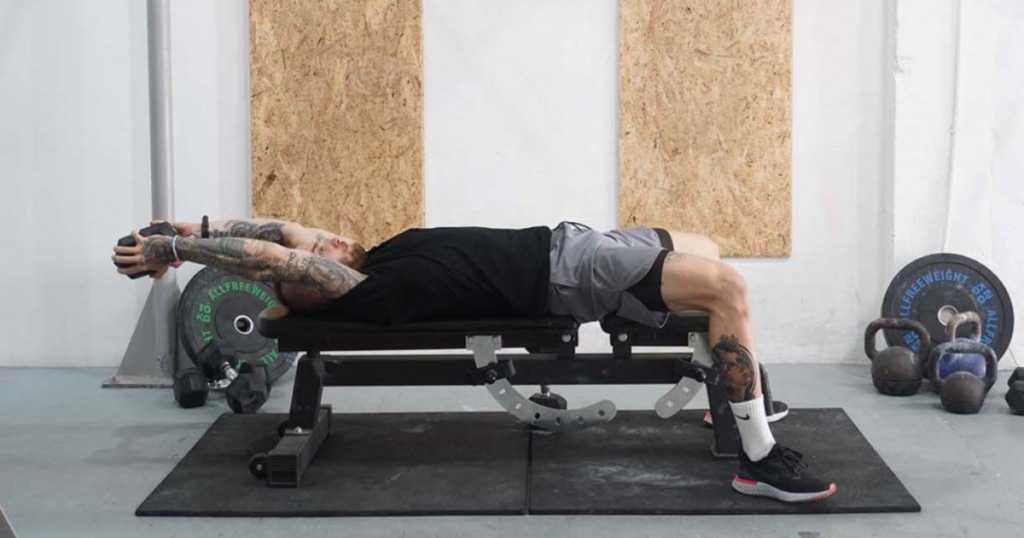
Dumbbell Seal Row
A version of the standard dumbbell row that works the latissimus dorsi, rhomboids, and rear deltoids—the muscles of the upper back—is the dumbbell seal row. Because you can’t cheat by using momentum when performing this exercise face down on a flat bench, it’s a really effective way to isolate and improve your back muscles. Here’s how to execute the dumbbell seal row correctly, step-by-step.
Step-by-Step Guide:
- Setup: To begin, choose a suitable pair of dumbbells that you can lift for the needed amount of repetitions without experiencing any discomfort. Straight front of you, place a level bench, and place the dumbbells on the floor on either side of the bench.
- Positioning: Place your stomach and chest firmly against the bench’s surface while lying face down. With your feet flat on the ground for support, extend your legs straight behind you. With your palms pointing inward, hold a dumbbell in each hand in a neutral grip, letting your arms dangle straight down towards the floor.
- Engage Core: Draw your navel towards your spine to activate your core muscles prior to starting the exercise. This keeps your lower back safe and helps to stabilise your body during the activity.
- Rowing Motion: Pull the dumbbells towards your hips while retracting your shoulder blades while holding the dumbbells in your hands and keeping your core firm. As you lift the dumbbells, keep your elbows close to your body and concentrate on tightening your back muscles at the peak of the exercise.
- Full Contraction: At the peak of the exercise, place the dumbbells directly beneath your rib cage and fully retract your shoulder blades. After a little pause to fully engage your back muscles, carefully lower the dumbbells back to the beginning position.
- Controlled Descent: Fight the impulse to rapidly return the dumbbells to their starting position. Rather, carefully lower them so that you may fully extend your arms without locking out your elbows. Keep the muscles in your back taut during the exercise’s descending phase.
Incline Rows
Incline rows, sometimes referred to as inverted rows or bodyweight rows, are an excellent way to work the muscles in your back, especially the upper back, while simultaneously working your shoulders and biceps. They provide comparable advantages with a different movement angle, making them a great substitute for conventional horizontal rows. Many pieces of equipment can be used for incline rows, such as a barbell, suspension trainer, or even a sturdy table.
Step-by-Step Guide:
- Setup: Locate a stable platform that is higher than the floor, like a bar in a squat rack, a low bar that is secure, or a suspension trainer that is fastened to a ceiling or door frame. To ensure that your body is at an inclined angle when you grasp it, adjust the height of the bar or the straps.
- Orientation: Face the bar or suspension trainer with your back to it. Reach up and grasp the bar with an overhand hold, little wider than shoulder-width apart, with your hands facing away from you. With your heels planted firmly on the floor and your arms outstretched, your torso should be fully extended.
- Body Alignment: Make sure your head and heels are in a straight line. Throughout the workout, keep this position by using your core muscles. Steer clear of sagging or arching your lower back.
- Execution: Bend your elbows and retract your shoulder blades to pull yourself up towards the bar. Maintaining a straight body, try to bring your chest closer to the bar. Towards the peak of the exercise, concentrate on tightening your back muscles.
- Controlled Descent: At the bottom of the exercise, allow your shoulder blades to protract, or move apart, and slowly lower yourself back to the starting position while fully extending your arms.
- Breathing: Take a breath as you go lower and release it as you raise yourself up to the bar. During the workout, keep your breathing rhythm consistent.
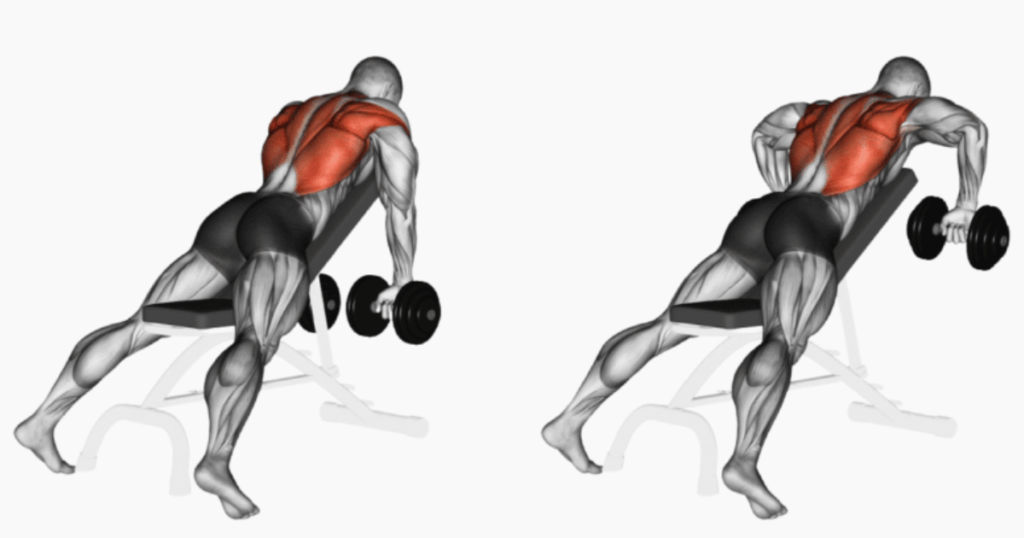
Dumbbell Pendlay Rows
A complex exercise that focuses mostly on the latissimus dorsi, rhomboids, and traps of the upper back is the dumbbell pendlay row. This exercise is good for developing general upper body strength and muscular mass because it works the biceps, rear deltoids, and core muscles.
Step-by-Step Guide:
- Set Up: Choose a pair of dumbbells that you can lift with good technique to start. Put them down in front of you on the floor.
- Positioning: Take a stand with your feet shoulder-width apart, bend your knees slightly, and bend forward at the hips. Throughout the exercise, maintain a neutral spine position by keeping your chest up and your back straight.
- hold: Spread your palms slightly wider than shoulder-width apart and reach down to grab the dumbbells with an overhand hold (palms facing you). Make sure you hold the dumbbells firmly.
- Pulling: Pull back your shoulder blades and contract your core muscles while holding the dumbbells. Your torso will be more stabilised as a result during the exercise.
- Rowing: Using your elbows as a guide, exhale as you draw the weights towards your lower ribs. At the peak of the exercise, keep your elbows close to your body and concentrate on pressing your shoulder blades together. Throughout the workout, your torso should stay still with little to no movement or motion.
- Hold and Squeeze: To get the most out of the contraction in your upper back muscles, stop briefly once the dumbbells are in your ribcage. While you maintain the top position, pay attention to the strain in your back muscles.
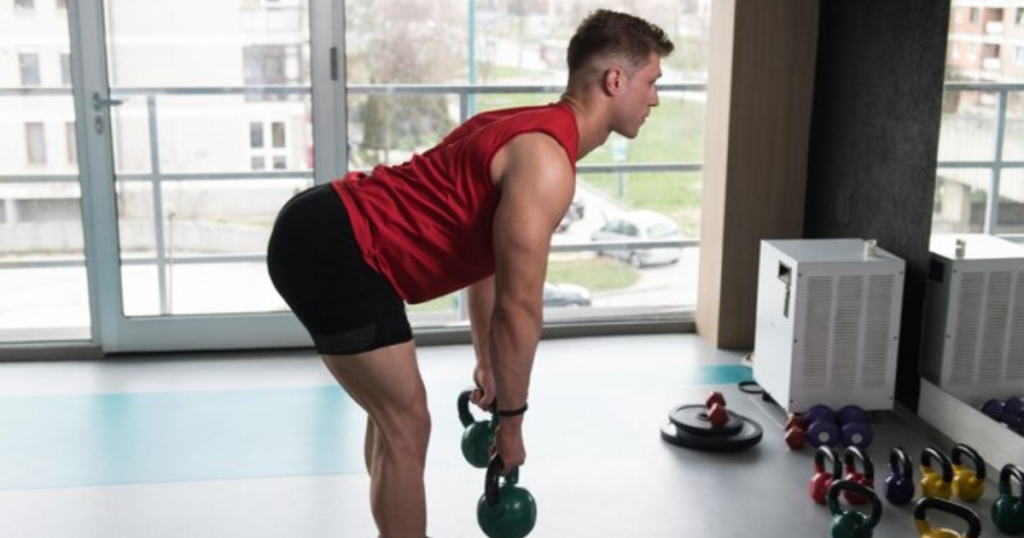
Renegade Row
A popular choice for strength training enthusiasts, the Renegade Row is a versatile and effective exercise that trains numerous muscle groups at once. This exercise mostly works the upper body muscles, such as the arms, shoulders, and back, but it also tests the stability of the core. The Renegade Row gained popularity first among athletes and fitness enthusiasts and has since become a mainstay in many training regimens because of its ability to improve coordination, strength, and stability.
Step-by-Step Guide:
- Grasp a pair of dumbbells with your hands while starting in the plank position. Your body should make a straight line from your head to your heels, with your wrists in line with your shoulders.
- To keep yourself stable throughout the workout, contract your core muscles. Maintain a level hip line and refrain from overly twisting or drooping.
- Keeping your elbow close to your body, row the dumbbell up off the floor and towards your chest with one hand. To activate your upper back muscles, concentrate on tightening your shoulder blades together at the peak of the exercise.
- Controllably return the dumbbell to its initial position while upholding stability and good technique.
- Lift the dumbbell towards your chest while maintaining your body’s stability and alignment while you repeat the rowing motion with the other arm.
- For the amount of repetitions or duration that you have chosen, keep switching rows between the arms.
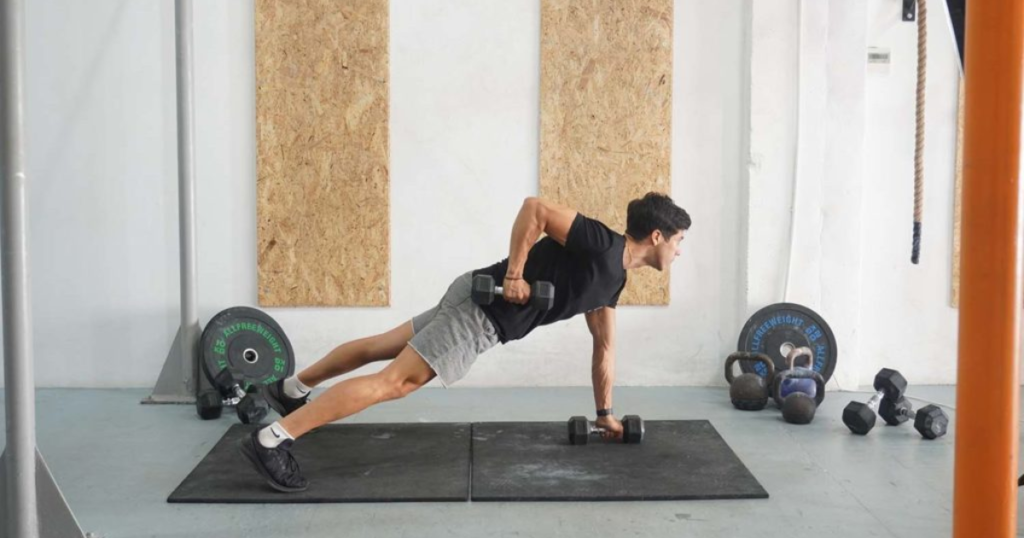
Kroc Row
Dumbbell row exercises are renamed as Kroc Rows in honour of bodybuilder and powerlifter Matt Kroc. The latissimus dorsi, rhomboids, and traps are among the upper back muscles that are mainly worked during this exercise; the biceps and forearms are also heavily worked. The effectiveness of Kroc Rows in increasing muscular mass, strength, and total back development is well documented.
Step-by-Step Guide:
- Setup: Start by deciding on a dumbbell with an appropriate weight. Because kroc rows are done for a lot of repetitions, you usually use a larger weight than you would for a standard dumbbell row. Set the dumbbell down close to a level bench.
- Setting up: Take a seat with your feet shoulder-width apart next to the level bench. Making sure your back is parallel to the floor, place your left knee and left hand on the bench. For stability, place your right foot firmly on the ground a little bit behind your body.
- Grip: Using a neutral grip—your palm facing your body—grasp the dumbbell with your right hand. To keep the dumbbell from slipping during the workout, make sure your grasp is firm.
- Rowing action: To begin, draw the dumbbell towards your hip with a smooth, controlled action by retracting your shoulder blade. When you raise the weight, keep your elbow close to your body.
- Complete Contraction: Your back muscles should be fully clenched and your upper arm should be nearly parallel to the ground at the peak of the movement. Squeeze your back muscles hard to get the most out of the workout.
- Lowering Phase: Return the dumbbell to its starting position gradually, letting your arm expand to its maximum length without tensing up your elbow. To keep the targeted muscles taut, maintain control during the descent.
Dumbbell Yates Row
A variation on the classic bent-over row exercise, the dumbbell Yates Row works the biceps and forearms in addition to the upper back muscles, specifically the latissimus dorsi, rhomboids, and traps. This workout, named for the renowned bodybuilder Dorian Yates, has a strong emphasis on precise technique and deliberate movement to enhance muscular activation and growth.
Step-by-Step Guide:
- Setup: To start, choose a suitable pair of dumbbells that you can lift with ease and proper form. Position your feet shoulder-width apart, bend your knees slightly, and grasp the dumbbells with an overhand grip in front of your thighs.
- Positioning: Lower your body until it is nearly parallel to the floor by hinging at the hips. To maintain a neutral spine, keep your chest up, your back straight, and your eyes forward. When your arms are fully extended, they should dangle directly beneath your shoulders.
- Engage Core: To keep your spine stable and avoid overly rounding or arching your back during a movement, brace your core muscles.
- Start the Row: Drive your elbows back and squeeze your shoulder blades together at the top of the exercise while exhaling as you pull the dumbbells towards your lower ribcage with a slight bend in your elbows. Hold your upper arms close to your sides and move in a smooth, deliberate manner.
- Concentrate on Squeeze: To optimise muscle contraction, halt momentarily at the peak of the exercise and concentrate on squeezing your back muscles. To prevent shrugging, make sure your shoulders stay down and away from your ears.
- Lower with Control: Take a breath and slowly lower the dumbbells to the beginning position, letting your arms extend fully without tensing up your elbows. Maintain your back muscles tense during the descent.
Creating a Lat Workout Routine
Lat Workout Routine:
1. Pull-Ups:
- Target Muscles: Biceps, forearms, and latissimus dorsi
- 4 sets of 8–12 repetitions
- Use resistance bands or an assisted pull-up machine if you are unable to perform bodyweight pull-ups.
2. Lat Pulldowns:
- Target Muscles: Biceps, forearms, and latissimus dorsi
- 4 sets of 8–12 repetitions
- Use resistance bands or an assisted pull-up machine if you are unable to perform bodyweight pull-ups.
3. Dumbbell Rows:
- Target Muscles: Lower Trastini, Rhomboids, and Latissimus Dorsi
- 3 sets x 10-12 reps each arm
- With a dumbbell in each hand, perform bent-over rows. Squeeze your shoulder blades together, keep your back flat, and draw the weight towards your hip.
4. Cable Rows:
- Target Muscles: rear delts, rhomboids, and latissimus dorsi
- 3 sets of 10–12 repetitions
- With your elbows pressed close to your body, pull the tight-grip handle towards your lower abdomen while sitting up straight and maintaining your chest up.
5. Straight-Arm Pulldowns:
- Target Muscles: anterior serratus, teres major, and latissimus dorsi
- 3 sets of 12–15 repetitions
- With your arms fully extended above and facing a high pulley machine with a straight bar connection, contract your lats to bring the bar down towards your thighs.
Choosing the Right Dumbbells for Lat Workouts
To choose the right dumbbells for lat workouts, consider factors such as your fitness level, strength, and the specific exercises you plan to perform. Start with a weight that allows for the desired number of repetitions with proper form while challenging your muscles. For beginners, lighter dumbbells are more suitable to ensure correct technique and reduce injury risk. Consider the range of lat exercises you plan to perform, such as dumbbell rows and straight-arm pulldowns, which may require lighter weights for higher repetitions to focus on muscle endurance and technique.
Choose dumbbells that feel comfortable to grip and maintain control throughout the exercise movements, such as ergonomic handles and non-slip grips. Opt for dumbbells that allow for progressive overload, such as adjustable dumbbells or sets with incrementally heavier weights. Consider space and budget when making your selection, as adjustable dumbbells offer versatility for various exercises and weight increments. Seek advice from a fitness professional or personal trainer to design a tailored workout plan.
Effective Lat Exercises with Dumbbells
Dumbbell Pullover
Start by holding a dumbbell above your chest while resting flat on a bench. Keep your arms slightly bent as you lower the weight behind your head. Contract your lats to bring yourself back to the beginning position.
Single-Arm Dumbbell Row
Maintain a shoulder-width distance between your feet while holding a dumbbell in one hand. Keep your back straight, flex your knees slightly, and pivot at the hips. Squeeze your lat muscle as you pull the dumbbell towards your hip, and then carefully reduce the weight.
Dumbbell Deadlift
“Grab a pair of dumbbells and place your palms facing each other to perform lat workouts with them. Maintain an upright posture and a straight back. With your back straight, bend forward from your hips and gradually lower the dumbbells to the floor. As you descend the dumbbells, make sure to push your shoulder blades together. Then, squeeze your back and butt muscles as you push through your heels to go back to the starting position.
Dumbbell Lat Raise
Hold a dumbbell in each hand, with the palms facing inward. When your arms are parallel to the floor, raise the dumbbells out to the sides and carefully lower them back down.
Related: 5 Best Boxing Workout Routine
Common Mistakes to Avoid
Maximising the efficiency of your lat workouts and lowering your risk of injury require avoiding common mistakes. Here are a few typical errors to steer clear of:
- Use Momentum: Avoid swinging or jerking weights to maximize exercise effectiveness and minimize injury risk. Focus on controlled, deliberate movements.
- Avoid Rounding the Back: Maintain a neutral spine and avoid rounded back during lat workouts. Keep shoulders back, chest up, and core tight.
- Inadequate Range of Motion: Complete each exercise to the fullest extent possible. Avoid shortened or partially completed repetitions.
- Ignoring Appropriate Form: Maintain steady posture, slow movement, and correct hand placement. Avoid shoulder sag or elbow flare-out.
- Overloading with Too Much Weight: Avoid using heavy weights that can cause poor form and injury. Start with lesser weights as strength increases.
- Ignoring Muscle Imbalances: Address any asymmetries or imbalances in muscles with specific exercises and corrective methods.
You may increase the efficiency of your lat workouts, lower your risk of injury, and reach your fitness goals more effectively by avoiding these frequent mistakes and placing a high priority on appropriate form, technique, and safety.
Conclusion
Exercises referred to as “Lat Workouts with Dumbbells” can improve posture, strengthen your upper body, and strengthen your back. You may achieve your fitness objectives and reap the rewards of having a strong, toned back if you perform these exercises correctly and consistently. Just be sure to select the appropriate weights, work out consistently, and employ proper form and technique.
Frequently Asked Questions
What are dumbbell lat exercises?
Exercises for strengthening and toning the latissimus dorsi, the muscles in your back, are called lat workouts with dumbbells. These lat-targeting and -toning workouts use dumbbells for motions like rows, pullovers, and pulldowns.
Are dumbbell lat workouts a good way to gain muscle?
Yes, without a doubt! Dumbbell lati exercises can be a highly powerful tool for developing back muscle. More so than any other equipment, dumbbells can help you isolate and target your lats while offering a wide range of motion. Your back’s strength and look can improve noticeably with regular dumbbell training.
Can I use dumbbells for lat training at home?
Yes, you may use dumbbells at home to perform lat workouts! Dumbbells and enough room to move about are all you need. You can perform a multitude of exercises that don’t require a lot of room or equipment, such as renegade rows, dumbbell pullovers, and bent-over rows. Just be careful to employ good form to avoid being hurt.
How frequently should I use dumbbells for lat workouts?
Dumbbell lat exercises should be incorporated into your total strength training regimen at least twice or thrice a week. In order to promote growth and healing, give your muscles time to relax and recuperate in between workouts. Additionally, you can alter the exercises’ intensity to maintain your tough exercises that avoid plateauing.









Leave a Reply